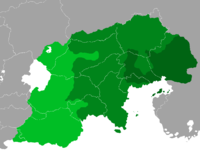Difference between revisions of "Nashaghan language"
| Line 37: | Line 37: | ||
}} | }} | ||
'''Nashaghan''' also spelled '''Nashkan''' or '''Najghan''' ({{cs|DAD|Nāšağan}}, ''Nâshağan''), is an extinct [[Vaniuan languages|Vaniuan literary language]] that was once widely spoken across [[Vaniua|Eastern Vaniua]] and remained a common literary language until the early 19th century. It was used across a wide geographic area, most prominently, around the populated regions of the [[Great Horde]]. This includes areas of modern-day [[Amaia]], [[Araman]], [[Balakia]], [[Baghazan]], [[Gushlia]], [[Shaghahan]], eastern [[Siyezan]], and northern [[Vaniua]] while establishing itself as the most spoken language in [[Komania]], [[Torosha]], northern [[Tarashik|Balakia]], and [[ | '''Nashaghan''' also spelled '''Nashkan''' or '''Najghan''' ({{cs|DAD|Nāšağan}}, ''Nâshağan''), is an extinct [[Vaniuan languages|Vaniuan literary language]] that was once widely spoken across [[Vaniua|Eastern Vaniua]] and remained a common literary language until the early 19th century. It was used across a wide geographic area, most prominently, around the populated regions of the [[Great Horde]]. This includes areas of modern-day [[Amaia]], [[Araman]], [[Balakia]], [[Baghazan]], [[Gushlia]], [[Shaghahan]], eastern [[Siyezan]], and northern [[Vaniua]] while establishing itself as the most spoken language in [[Komania]], [[Torosha]], northern [[Tarashik|Balakia]], [[Qamatudh]] and to a lesser extent [[Baghazan]], developing into several dialects. | ||
The literary form of Nashaghan is the predecessor of the modern [[Nashghani languages|Nashghani branch]] of Vaniuan languages, which includes the [[Koman language|Koman]] dialect continuum and [[Qamatudhi language|Qamatudhi]] as well as minor languages such as [[Dawari language|Dawari]]. The [[Jazaghan language]], which later evolved into modern Balak, is not considered part of the Nasghani branch but has nonetheless been heavily influenced by it. | The literary form of Nashaghan is the predecessor of the modern [[Nashghani languages|Nashghani branch]] of Vaniuan languages, which includes the [[Koman language|Koman]] dialect continuum and [[Qamatudhi language|Qamatudhi]] as well as minor languages such as [[Dawari language|Dawari]] or [[Ghalar language|Ghalar]]. The [[Jazaghan language]], which later evolved into modern Balak, is not considered part of the Nasghani branch but has nonetheless been heavily influenced by it. | ||
==History== | ==History== | ||
Revision as of 12:33, 11 December 2023
| Nashaghan | |
|---|---|
| Nāšağan Nâshağan | |
 Sprachraum of the Nashaghan language throughout the Great Horde
Western dialect
Central dialect
Eastern dialect . | |
| Region | Vaniua |
| Extinct | Around 1811 |
| Language family | Vaniuan
|
| Early forms: | Kalkali (Tamiric)
|
| Writing system | Tamiri script (Adhemsha) |
| Official status | |
| Official language in | |
| CWS code | – |
Nashaghan also spelled Nashkan or Najghan (Nāšağan, Nâshağan), is an extinct Vaniuan literary language that was once widely spoken across Eastern Vaniua and remained a common literary language until the early 19th century. It was used across a wide geographic area, most prominently, around the populated regions of the Great Horde. This includes areas of modern-day Amaia, Araman, Balakia, Baghazan, Gushlia, Shaghahan, eastern Siyezan, and northern Vaniua while establishing itself as the most spoken language in Komania, Torosha, northern Balakia, Qamatudh and to a lesser extent Baghazan, developing into several dialects.
The literary form of Nashaghan is the predecessor of the modern Nashghani branch of Vaniuan languages, which includes the Koman dialect continuum and Qamatudhi as well as minor languages such as Dawari or Ghalar. The Jazaghan language, which later evolved into modern Balak, is not considered part of the Nasghani branch but has nonetheless been heavily influenced by it.
History
Names
Literature
Official status
Phonology
Grammar
Vocabulary
Writing system
Sample text
See also
| English | fire | month | new | mother | sister | night | nose | three | red | yellow | green | horse |
|---|---|---|---|---|---|---|---|---|---|---|---|---|
| Western Nashaghan | wo [wo] |
boh [woh] |
hadjar / haj [hɒdʒɒr] |
mâshæ [mɒːʃæ] |
shan [ʃɒ] |
bôhd [βoːð] |
nîn / nîm [nʲin] |
mêza [mʲæsä] |
dəsh [dəʃ] |
shâda [ʃɒːðä] |
shêdan [ʃəːðän] |
wurəm [wurəm] |
| Central Nashaghan | wo [wo] |
bôh [wuː] |
hadjar / haj [hɒdʒɒr] |
mâshæ [mɒːʃɛ] |
san [sɒ] |
bôhd [βuːð] |
nem [nem] |
mæza [mæzä] |
təz [təz] |
shaza [ʃɒzä] |
shəzan [ʃəːzän] |
wurəm [wurəm] |
| Eastern Nashaghan | wu [wu] |
bôh [wuː] |
hajj [hɑdz] |
mâshe [mɑːʃe] |
shan [ʃɑ] |
bôhd [wuːð] |
nem [nem] |
meza [mezä] |
təshe / dəshe [tɯʃe] |
shâda [ʃɑːðä] |
shêdan [ʃɯːðän] |
wurəm [wurɯm] |
| Modern Koman | wo [βo] |
woh [βoː] |
hajar / haj [häʒär] |
mâşe [mɒːʂe̞] |
şa [ʂɒ] |
bahḍ [βɒːð] |
nîn / nîm [nʲin] |
mêza [mʲe̞zä] |
təse / dəşe [təse] |
saja [sɒʒä] |
şêzan [ʂəːzän] |
wûrəm [βuːrəm] |
| Balak | vu / vuğas [vʊ] / [vʊɣɑs] |
- [] |
yar [jɑɾ] |
báş [baʃ] |
son [sɔn] |
vud [vʊd] |
ném [nem] |
bezá [bɛza] |
tes [tɛs] |
- [] |
- [] |
virem [vɪɾɛm] |
| Khezian | va [βu] |
ctasu [ʃtɐsu] |
anar [ɐnäs] |
maja [mäʒɐ] |
urva [urvɐ] |
carv [ʃɐrv] |
ciy [ʃɪ] |
bez [bɪz] |
dor [dʊs] |
uafisi [u:fɪsɪ] |
zota [zotɐ] |
vir [vis] |
| Vucheshian | vo [βɔ] |
fağâ [ɸɑʁʌ̽] |
- [] |
maye [mɑjɛ] |
- [] |
- [] |
- [] |
- [] |
tısı [tɯ̽sɯ̽] |
- [] |
- [] |
vuli [βʊlɪ] |
| Northern Vucheshian | vā [vɒː] |
fağā [fɒɰɒː] |
- [] |
mane [mɒnə] |
- [] |
- [] |
- [] |
- [] |
tiṣi [tisi] |
- [] |
- [] |
vuyēm [vʉʝəːm] |
| Vosan | va [va] |
conås [ʃonɒs] |
ane [ane] |
mance [manʃe] |
esâ [esja] |
car [ʃas] |
cî [ʃji] |
bes [bes] |
duro [duro] |
zanesîd / ağlîd [zanesjid] |
zoltâ [zoltja] |
vurô [vurjo] |